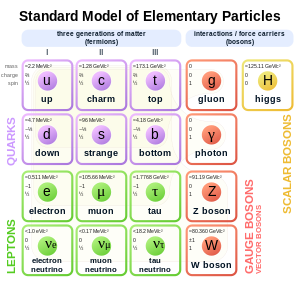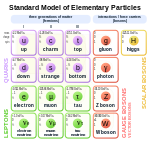Gauge boson

In
Gauge bosons are different from the other kinds of bosons: first, fundamental
Gauge bosons in the Standard Model
The
Isolated gluons do not occur because they are colour-charged and subject to colour confinement.
Multiplicity of gauge bosons
In a
Massive gauge bosons
According to the Standard Model, the W and Z bosons gain mass via the
Beyond the Standard Model
Grand unification theories
The Georgi–Glashow model predicts additional gauge bosons named X and Y bosons. The hypothetical X and Y bosons mediate interactions between quarks and leptons, hence violating conservation of baryon number and causing proton decay. Such bosons would be even more massive than W and Z bosons due to symmetry breaking. Analysis of data collected from such sources as the Super-Kamiokande neutrino detector has yielded no evidence of X and Y bosons.[citation needed]
Gravitons
The fourth fundamental interaction,
W′ and Z′ bosons
W′ and Z′ bosons refer to hypothetical new gauge bosons (named in analogy with the Standard Model W and Z bosons).
See also
References
- ISBN 0-684-85578-X.
- ISBN 0-7607-4616-8.)
{{cite book}}: CS1 maint: multiple names: authors list (link - ISBN 981-238-149-X.
- ^ "CERN and the Higgs boson". CERN. Archived from the original on 23 November 2016. Retrieved 23 November 2016.

